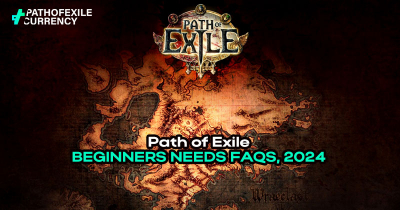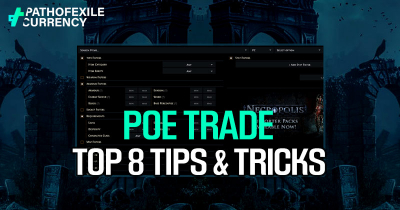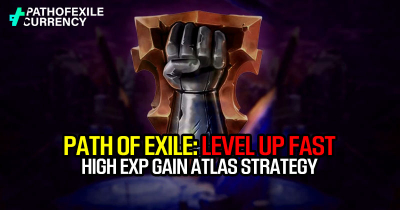Path of Exile Beginner Guide: Basics & Campaign - Part 1
- Jackson
- Share
- Path of Exile
- 03/14/24
- 1165

This ultimate Guide to Basics in Path of Exile is a valuable tool for new players, who are looking forward to exploring Wraeclast. It provides you with an introduction that gives you the basics to kick-start your journey such as different leagues explained briefly, character classes overviewed and a few handy hints.
- League
- Classes Overview
- Class Ascendancy
- First Steps
- Gem
- Skill Gems
- Attributes
- Item Sockets, Links & Colours
- Currency System
- Item Quality
- Item Rarity
- Passive Skill Tree
- Flasks
- Auras
- Crafting Bench
- Basics of Damage
- More versus Increased
- Armour, Evasion & Energy Shield
- Resistances
- Mitigation & Avoidance & Recovery
- Ailments
↖ League
Before even raising your first weapon, one must choose the battleground—league. You can think about it as if PoE had several worlds or separate modes within itself. Here's a brief preview:
| League | Description |
|---|---|
| Challenge | Fresh start! Every 3-4 months a brand-new challenge league comes up with unique content. For new players this is ideal – everyone starts from scratch here so there is no advantage for veterans here who have deep pockets and veterans are not your competitors anymore since economy has been rebooted. |
| Standard | The great archive of past heroes after Challenge Leagues close down. After challenge leagues end, characters move into this place. Economy has been established more (read: it's pricier), however all contents are accessible here also making it less friendly towards beginners but still an option if you won't mind trying. |
| Hardcore | Not for the faint-hearted! Once killed in this mode, a character gets transferred directly to Standard. Exciting but severe at the same time our advice? Start getting used to playing in Softcore where death isn't permanent until now. |
- Solo Self-Found (SSF): The badge of honor worn by lone wolves! No trading allowed; depend on yourself only and hope for loot drops as well as use wit only when playing PoE this way. A tough but enjoyable mode that can be disabled if you are lonely.
- Ruthless: Ignore this for now. It is a mode for old-timers, enthusiastic about the unflappable, slow feel of the past. Save this one for when you're a PoE sage.
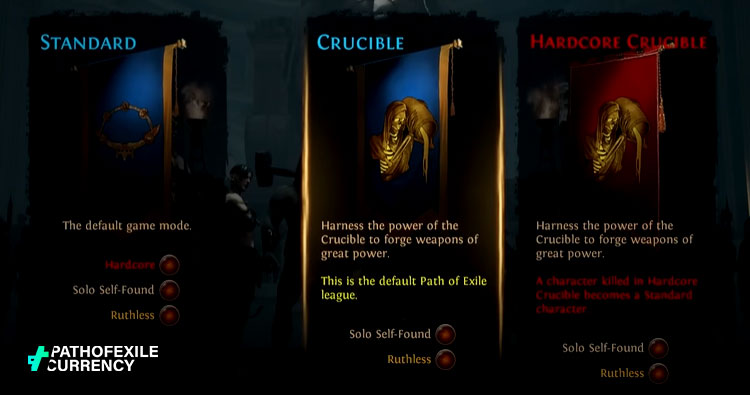
↖ Classes Overview
Entering character selection screen is like stepping into a big armory—all with different arms and armor—seven classes to meet your every need.
![]() The Scion can only be seen after Act 3 is defeated, so let's just consider the first six:
The Scion can only be seen after Act 3 is defeated, so let's just consider the first six:
| Class | Avatar | Description |
|---|---|---|
| Templar |
|
Magic warrior who employs both attack and defense strategies. |
| Shadow |
|
Lightly armored agile assassin capable of setting traps and executing swift attacks. |
| Marauder |
|
Muscular melee brawler who enjoys fighting up close and personal. |
| Ranger |
|
Swift archer that strikes down enemies from afar with quickness and accuracy. |
| Duelist |
|
Graceful warrior blending strength with dexterity to create effective offense. |
| Witch |
|
Archetypal sorceress using minions or her elemental fury as weapons. |
Every class in Path of Exile has access to all skills available in the game but they start at different points on an expansive skill tree and have unique subclasses called ascendancies for each of them.The beginning point just picks which way you want your epic tale to go.
Tip: Feeling overwhelmed? There is no shame in finding a build guide made by experienced exiles, it's sort of like having a mentor in your corner!
↖ Class Ascendancy
Ah, Classes Ascendancy – the secret to unlocking your character's potential. Located in Act 3's Aspirant's Plaza, this subclass system is locked behind trials and tribulations (quite literally).
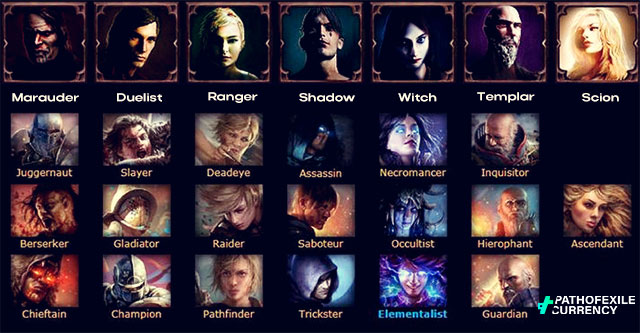
In between level 35-45, as you progress through the campaign, you'll unlock subclasses that continue to refine your character abilities:
- Templar: Guardians are defenders and support. Hierophants command totems to cast spells on their behalf while Inquisitors focus on critical strikes and elemental damage.
- Shadow: It specializes in critical strikes and evasive maneuvers; ideal for hit-and-run tactics. Opt for Assassin, Saboteur, or Trickster. Assassins deliver high damage and thrive in one-on-one combat, Saboteurs excel with traps and mines, while Tricksters are versatile jacks-of-all-trades.
- Marauder: Enhances brute strength or elemental resistance for those who like to tank? You can choose between Berserker, Juggernaut or Chieftain. Berserkers forsake defense for raw damage and speed, Juggernauts are nearly impenetrable tanks, and Chieftains wield fire and totems with an attack focus.
- Ranger: Tactical advantages like projectile prowess and finesse with flasks are its main aim. Specialize as a Deadeye, Raider or Pathfinder. Deadeyes dominate with ranged attacks Raiders are elusive speedsters with versatile attack builds Pathfinders although complicated rely on flasks for immense power.
- Duelist: This class has offensive perks mixed up with defensive ones enabling adaptable combat strategies. Choose Champion, Slayer or Gladiator. Champions are balanced powerhouses, Slayers have potent life leech mechanics while Gladiators strip bleed effects along defensive lines.
- Witch: Embrace dark arts as a Necromancer or go elemental chaos with it causing havoc. Choose Elementalist, Occultist or Necromancer. Elementalists deal with elemental ailments and damage while Occultists practice dark arts using curses as their main weapon and Necromancers raise armies of minions.
- Scions: They have a single Ascendancy class which offers flexibility to mix elements from other classes. Nonetheless, it is this complexity that makes them ill-suited for beginners.
Remember, PoE rewards creativity but punishes indecision. Starting as a Jack-of-all-trades might seem appealing but can lead to a master of none situation. Choose wisely!
How to Unlock Ascendancy?
- Find the Trials: These trials are scattered across various acts and they challenge you with traps and puzzles.
- Complete Six Trials: Each one brings you closer to the Labyrinth.
- Navigate the Labyrinth: A maze filled with dangers and rewards awaits.
- Choose Your Ascendancy: After Labyrinth's end point, select your subclass thereby allocating points.
- Enchant Your Gear: Gloves, boots or helmets can be enchanted using Divine Font.
- Open Treasure Chests: Based on your performance in the Labrinth earn treasure keys!
- Stay Alive: In case of death all progress is lost therefore ensure you always have life flasks at hand!
Additional Tips:
- Traps are percentage based damage so even high level characters must tread carefully.
- The Labyrinth has four tiers; each one grants two Ascendancy points upon completion.
- To switch your ascendancy points or class make sure you respect your points first.
↖ First Steps
Upon entering the game, you'll see a user interface that serves as both your command center and your lifeline. Here's what you need to know about it.
- Health and Mana: Down leftwards there is a Life Globe which represents your health. Some characters may also have an Energy Shield, which provides another layer of protection between damage and health. Conversely, below this on the right side you will find the globe that holds your mana – without it you can't use any skills.
- Flasks: These are consumable items that take up slots at the bottom of the screen. They can restore life and mana or augment other aspects of gameplay such as movement speed enhancements. Always use them wisely!
- Skill Bar: This is where your abilities and spells will appear. There's a default attack present when you begin but soon enough it will be replaced by more powerful abilities.
- Cosmetic and Storage Shop: The shop button is there for aesthetic and convenience upgrades—rest assured, Path of Exile prides itself on being a non-pay-to-win experience.

As soon as you kill your first enemy called Hungry Corpse, most likely; you shall get hold of your first item namely Driftwood Wand; or even receive a gem as your skill for the first time ever.
↖ Gem
After reaching town and taking a break from fighting, it is time to get into gem mechanics in-depth:
- Gem Tags: Active skill gems are labeled Projectile, Spell, AOE or Fire. These tags assist you so that you can choose the right passive skills to enhance your abilities.
- Support Gem Synergy: Support gems have their own tags and properties. They could even change how a skill operates or boost its potency. Please remember that spells scale with cast speed while attacks scale with attack speed—choose supports that match your playstyle.
- Levelling Gems: Gems gain experience and level up as you do, provided they're socketed in your gear. However, higher-lvl gems might require higher attributes on your character.
- Managing Gem Levels: If you do not meet the required conditions for progressing a gem further at the moment, you can either decide to pause or go ahead and level it up. Simply click or right-click the plus sign next to the gem experience bar whenever it is needed.
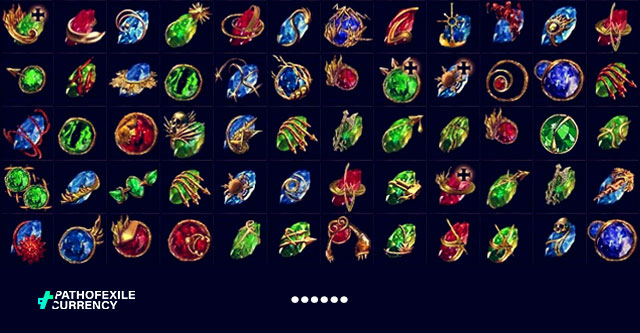
↖ Skill Gems
In Path of Exile any class can use any skill; It's about the gems. Here's what this means:
- Active Skill Gems: With these gems, players now have skills such as Fireball. The only requirement is that they must be put into equipment sockets—not only weapons.
- Support Gems: Unlike active skill gems, support ones don't grant new skills but instead make existing ones more powerful. To work, they need an active skill gem within your gear linked to them.
- Socketing and Linking: Put simply, in order for my Fireball to be boosted by Arcane Surge Support all I need is link both of them via relevant sockets in my gear? Therefore, if an active skill gem has more support gems linked to it then it becomes powerful—and mana-hungry too.
↖ Attributes
In Path of Exile there are three main character attributes:
| Strength (Red) | The physical attribute, strength helps with life and melee damage. Every two points of strength increase maximum HP by one, while every five points increase melee physical damage by 1%. |
| Intelligence (Blue) | This attribute mostly applies to casters such as mages or wizards who use a lot of mana when casting spells and have low defenses due to the little armor they have equipped in their equipment. Every two points in intelligence add +1 mana, while every five points enhance your energy shield by 1%. |
| Dexterity (Green) | It's all about bows and arrows here for dexterity! Each point in dexterity provides +2 accuracy, and every five points offer a +1% increase in evasion. |
Remember that red means strength, blue indicates intelligence while green is associated with dexterity so as you can easily understand sockets and skill gems more precisely. Nevertheless, do not overdo on stacking them up; they are mainly meant to fulfill certain gear requirements and work together with particular skill gems.

While some builds do focus on maximizing certain attributes for specific synergies, for most adventurers, meeting the minimum needed to wield gear and level up gems is sufficient.
↖ Item Sockets, Links & Colours
In PoE your equipment has slots inside which you place skill gems. These sockets come in three colors that correspond to the main attributes:
- Red Sockets: Best-suited for those based on strength.
- Blue Sockets: Designed specifically for those who rely upon intelligence.
- Green Sockets: Primarily dex-based characters are encouraged here.
The possibility of rolling a given socket color on an item are affected by the requirements for its attributes. Take, for instance, green sockets are more likely to be found in items that require high dexterity.
The most important thing which empowers your character is linkages between sockets. Linking sockets lets you use support gems with skill gems to improve their performance. The more the links an item has, the more intricate and stronger combinations can be made.
↖ Currency System
Forget all those things you know about gold coins and platinum pieces; the currency system of PoE changes that idea around completely, with your pockets being filled with numerous crafting materials that can also be used as currency. Let's break it down:
- Chaos Orbs: These are often referred to as the gold standard of PoE economy and they are perfect for trading and measurement of values.
- Jeweler's Orbs: More or less sockets on your gear? These orbs do it.
- Orbs of Fusing: Want to fuse them into skill combinations? Go ahead with these orbs!
- Chromatic Orbs: Do not like the color of your sockets? Change it up matching them to your skill gems using these beauties.
- Scroll of Wisdom: The basic unit for identification. Got a mysterious item? Learn secrets with one click.
- Portal Scroll: Need a quick exit? This scroll zaps you back to town faster than you can say "Dominus".
- Enkindling Orb: Flasks take damage but cannot recharge during use. Big bosses beware!
- Instilling Orb: Put shyness aside while using flask – this orb will do everything for you. "Used when charges reach full"? Yes, please!
- Orb of Transmutation: Upgrades normal items to magic ones. It's like getting a little promotion for your gear.
- Orb of Alteration: Don't like the mods on your magic item? Spin again!
- Orb of Augmentation: Adds one more mod (a little bit spicy) to an already magical item.
- Orb of Alchemy: Turn simple items into rare ones by adding mods to them with this golden touch.
- Regal Orb: Used in upgrading Magical items into Rares through addition of a single mod.
- Divine Orb: When RNGesus smiles, you can re-roll numerical values on items for better or worse stats.
- Exalted Orb : Adds random modifier to rare item as it is the most sought after currency type.
- Chromatic Orb: Not happy? Try rolling dice with another color scheme
- Orb of Scouring: This simply removes all the modifiers from an item that has some of them
- Vaal Orb: A completely corrupted item may have unintended outcomes (such as white socket).
These currencies are not only means of exchange but also assets for player's personalization. However, be mindful about using these currencies because it is gaming. A Jeweler's orb usage might either increase your socket count or decrease it; it's all up to chance. Similarly, Orbs of Fusing's linking and alteration in Chromatic Orbs' colors can mess things up for good too.
↖ Item Quality
Now let us add a little bit more quality to those items:
- Blacksmith's Whetstone: Enhance physical damage on weapons.
- Armourer's Scrap: Let no one punch through your armor.
- Glassblower's Bauble: They say it never ends with flasks.
- Gemcutter's Prism: As well as gems need an update.
Stick to normal items when you are applying quality; magic, rare or unique items are not very effective in this case. And here's a hint for you: keep those Gemcutter Prisms until that moment when a level 20 gem can be upgraded to 20% quality at once.
Got an item with three linked sockets of different colors? Trade it off with the vendor for one Chromatic Orb. And these are only some of the “vendor recipes.”
It is harder to get many links and more sockets. Also, bear in mind about socket color affinity: red ones come on strength requiring items, blue on intelligence needing things and green on dexterity required stuff.
↖ Item Rarity
If anything, now that we have understood currency and sockets let us discuss loot. There are four types of rarity which items can possess:
| Normal (White) | These are your basic items—plain and simple. |
| Magic (Blue) | Such kind of gear has two enchantments like extra armor or attribute bonuses. |
| Rare (Yellow) | Rare finds can boast up to six mods, offering a plethora of bonuses. |
| Unique (Orange) | These are the crown jewels of PoE gear. Unique items have fixed properties that can define entire builds. |
Knowing item rarity matters as it defines relative power and trade values.Normals kick off your gear creation; magics colorize them; rares turn them into art pieces; uniques? They're the showstopper exhibits in any museum gallery presentation!
↖ Passive Skill Tree
When you look at the Passive Skill Tree in Path of Exile for the first time, it may appear to be a sprawling mess of confusion. But don't worry! Essentially, the tree consists of passive bonuses that are like stepping stones to the ultimate build your character has. Each level up gives you a skill point and a few extra can come from certain quests. There are as many as 123 points available.
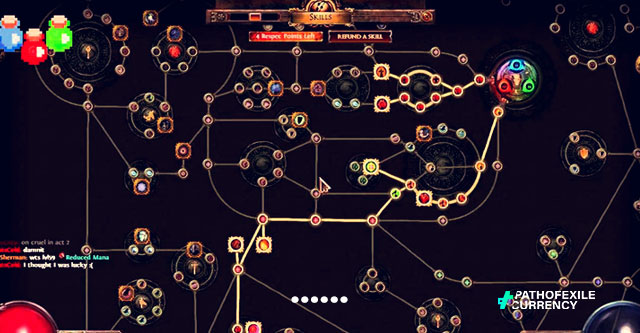
Attributes and Colors
The three main sections into which this tree is divided correspond to the core attributes: Strength, Dexterity, and Intelligence respectively. Your starting class determines where you begin on this map:
- Marauders start in Strength territory.
- Rangers are natives of Dexterity region.
- Witches spawn among Intelligence nodes.
- Duelists (Strength/Dexterity) and Templars (Strength/Intelligence), however, find themselves at attribute intersections.
First Points
After leveling up, players have to choose one node adjacent to their initial position on the grid. Clicking on a node shows its benefits—whether projectile damage or attack speed—and an “Apply Points” button will lock your choice. Remember to save often; misclicks can be costly.
Customizing Build
It's up to you how your character will go forward. Do you need more damage or faster movement? The tree has got all that covered. And do not hesitate about moving into other attribute territories – it is there where one can find most intriguing nodes.
Newbie Pitfall
Offense alone isn't everything, especially if you're new to the game. Newcomers frequently miss life nodes only to end up dying again and again. To avoid this trap, make sure you invest in survivability too because balance is key here.
Refunding Points
Made some mistake? Orbs of Regret are your get-out-of-jail-free cards; they allow reallocating points anytime you want so that you can fix a mistake. These can be earned through gameplay or as quest rewards, up to 20 from just completing quests.
The Search Bar
Lost? The tree's search bar is your needle on the compass. For example, if you type in something like projectile or fire, it will highlight all relevant nodes across the tree making it easier for you to plan your path.
Nodes Explained
The various flavors of the nodes are:
- Small Nodes: Give minor boosts.
- Notables: Offer considerable buffs and are very powerful.
- Masteries: They are specializations within a cluster that further refine or enhance your build.
- Keystones: Nerve-wracking high risk high return type of node that can shape a build.
- Jewel Sockets: Customizable slots for crafted Jewels that give specific bonuses.
Following Build Guide
Entering the Passive Skill Tree without help is one thing; and quite terrifying. Being new to the game, following an established build guide is essential because it saves time wasted on trial-and-error approaches by giving you a roadmap for success.
↖ Flasks
In PoE, flasks aren't just any health potion which you guzzle down and forget about. They are an intricate component of your survival gear. Here is what you need to remember:
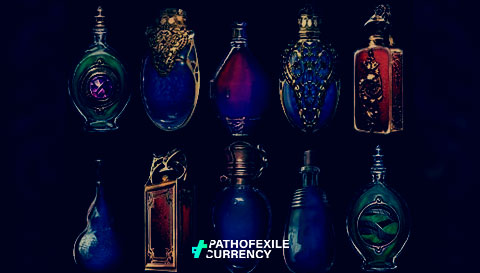
-
Types of Flasks: There exist four main types:
- Life Flasks: These are your go-to healers. They refill life slowly over duration.
- Mana Flasks: If there was a way to shoot arrows without having any arrows, running out of mana is exactly what that would feel like. Mana flasks regenerate mana over time.
- Utility Flasks: These ones have all sorts of goodies in them – think Swiss Army knives but flasks instead – such as increased speed and evasion.
- Hybrid Flasks: For now though, let us focus only on three major categories which include life and mana restoratives.
- Flasks Filling up: Every time you slay a monster or defeat a boss with some skill in Path of Exile, you will be rewarded with charges that fill up your flasks.
- Customizing Your Flasks: You can tailor your flasks just like adjusting a suit that fits well. Put mods which give additional charges or counter curses on them. Handle them like they are the most important weapons and armor in the game.
- Life/Mana vs Utility: Life and Mana flasks refill automatically as health and Mana are drained from them; however, utility ones are proactive since their effects last till the end of their duration timer.
- Upgrading Flasks: As you get stronger, so should your flasks grow too. When you have three items of the same tier, vendors will accept them as payment for higher tiers. It is a progression step from tricycle to bike exchange.
↖ Auras
Path of Exile Auras are more like an invisible fan club buffing its members secretly whenever they participate in any activity that requires power. Here's how to use them:
- What Are Auras?: These are skills gems whose activation brings about passive buffs on characters such as increased fire damage per second or additional movement speed among others.These could be equated to background music for each character's epic story line.
- Reservation of Mana: When an aura is activated it consumes part of your mana bar as reservation cost. Reserved mana resembles money stored in a savings account that cannot be accessed until turned off.
- Building around Auras: The best builds seek to get maximum possible power out their aura while still having just enough mana left to cast other spells.
- Reservation Efficiency for Mana: Making changes to total amount reserves by an aura because total manasize does not really matter only increases mana reservation efficiency leads upto higher number or simultaneously stronger aura making without running out of mana.
- Percentage vs Flat Reservation: Some auras do not reserve mana as a percentage but rather in flat amounts. Percentage reservations are influenced by the total amount of mana pool you have, yet flat reservations are not affected that much.
- Reserving Life: By means of Arrogance Support Gem, one can replace Mana with his/her life pool as a source for particular Aura skills. Such strategy is so daring and requires much caution.
↖ Crafting Bench
The Crafting Bench is like having a magical toolbox in your pocket to help you make the most out of your gear. It can be found at your hideout (or from decorations in case it was misplaced) and it is a game changer whether you are new or a veteran player.
Using the Crafting Bench?
- Finding Your Bench: Usually in your hideout. If lost, get it back from decorations.
- Deciding on Your Mod(s): Fire resistance? Dexterity? Whatever it is, look no further than the bench!
- Pay Up: All Mods Require Some In-Game Currency To Purchase
- Leveling Up: As you advance through various stages of this game high level crafting recipes will start revealing themselves.
- Special Crafts: We will discuss these later; stay tuned for advanced crafting secrets.
- Overwrite Caution: Changing one mod? An additional Orb of Scouring must be spent.
Remember that while crafted mods may not always be top-tier ones, they go far towards fine-tuning resistances and stats throughout the game's progression path!
↖ Basics of Damage
Understanding damage intricacies in PoE will give you a major advantage. This is a simplified breakdown:
- Spells vs Attacks: Damage spells are determined by the level of the skill gem itself. Higher levels result in better damage. However, attacks depend on weapon stats which include their base physical damage.
- Gem Tags: Tagged names of gems such as Fireball or Ground Slam gives vital information like cast time for spells and attack speed for attacks.
- Critical Strikes: Both spells and attacks can critically hit. The spell's gem displays its base critical chance while an attack has its base critical chance linked to the weapon used.
- Added Damage Effectiveness: Some skills benefit from added damage in different elements. This depends on each skill and is important for optimization of your build.
- Weapon Importance: For attack-based skills, always seek to improve your weapon. The overall output depends heavily on factors such as base damage or attack speed and critical chance among other things.
- Local vs Global Mods: Weapon mods can be local, affecting only that weapon (e.g., increased physical damage), or global, which apply to your character as a whole (e.g., increased spell damage).
- Spellcaster Weapons: Wands, staves and rune daggers offer mods beneficial to spellcasters such as increased spell damage or added damage to spells.
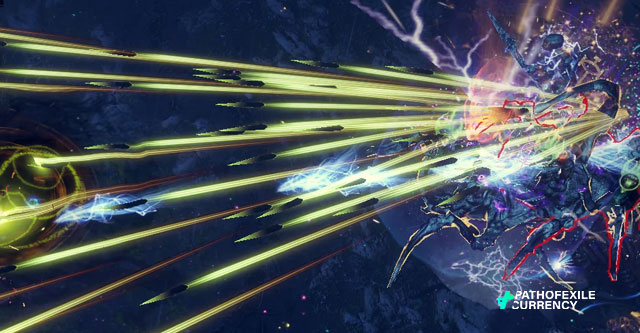
↖ More versus Increased
In PoE, killing enemies efficiently requires using well-placed modifiers. Nevertheless, not all these modifications are created equal with some being just marginal while others are exponential. You might have noticed terms like increased or more used extensively in this game like salt in a salad dressing but what's the difference?
- Increased Damage: Think of it as increased being cumulative effect out of countless little increases you pick up along your way. Be it from passive tree or gear, these percentages add up into one massive total. For instance, if base damage is 100 and you've amassed 500% increased damage, then you are now dealing a sum of 600 damages.
- More Damage: Now comes the interesting part - more damage acts as that secret ingredient which amplifies all your overall damage output. In our previous example, if a gem giving an additional 39% more damage is added to the total of 600, it's not just adding another 39 on top; rather it boosts everything to reach 834 (600x1.39).
- Simply put: increased adds up and its value diminishes with increments while more multiplies and often leads to much greater increase in your damage.
↖ Armour, Evasion & Energy Shield
In PoE, surviving does not only rely on how well we can hit but also on how many times we get beaten by opponents. Let us break down the three main defences here: armour; evasion; and energy shield.
Armour:
- What is it? Armour reduces physical damage, but only physical damages.
- How does this work? Think about Armour as a cushion for smaller blows. It provides better protection against multiple pebbles than against single boulder.
- There is one catch with it though – as individual hits get more damaging armor's efficacy decreases
Evasion:
- What is it? Evasion lets you totally avoid enemy attacks.
- How does this work? Your evasion rating equates to dodge chance. It's also not exactly random—thanks to entropy, there won't be strings of bad luck hits for your character.
- Did you know that evasion only helps a character avoid physical attacks and not spells? You should remember this when you see a rogue exile who is going to use spells against you.
Energy Shield:
- What it does: It serves as an extra life pool which takes damage before your HP (excluding chaos damage).
- How it recovers: Regenerates naturally after a brief amount of time without taking any damage.
- Pro tip: The Energy Shield is gear-dependent. If you are new to the game, maybe don't put all eggs in one basket until you've got the gear for it.
↖ Resistances
Now let's talk about resistances because, trust us, you want to hear this. In Path of Exile, resistances are your salvation from fire, cold, lightning or that awful Chaos Damage.
Why Resistances Matter?
- The basics: These simply reduce incoming elemental damage.
- The numbers game: At 75% resistance (the cap for fire, cold and lightning), you only take a quarter of the damage.
- The goal: This means that your aim must be to cap them as soon as possible. It's not just good advice; it's survival necessities.
Chaos Resistance
- Less critical but still important: Chaos resistance is harder to come by and often lower than other resistances.
- Watch out for debuffs : Some story milestones will drop all your resists. Keep some eye on your gear so we can stay in positive!
Where to Find Resistances?
- Gear up: Look at the equipment , especially jewelry where there are resistances available .
- Aura advantage: From Act 3 onwards consider using Purity of Elements Aura for another resistance boost on top of ailment immunity.
↖ Mitigation & Avoidance & Recovery
In PoE staying alive is an art. Here's how:
Mitigation:
First things first mitigation is what allows your character to shrug off damage like it's nothing. How do you buff up your defenses? Here is the low-down:
- Armor & Resistances: These are the two most important aspects of your defense. Armor reduces physical damage while resistances reduce elemental and chaos damage. Remember that without a good mitigation plan, a single hit can send you back to the respawns faster than one can say “RIP.”
- Physical Damage Reduction: You heard about endurance charges right? They provide 4% physical damage reduction each. It is as though you had a hidden shield making those hits feel like tickles.
- Phys-as-Ele Conversion: This clever trick converts part of any incoming physical blow into an elemental one . Why's that cool? Because chances are high that you have resistances for these types of damage thus making this attack less painful.
Avoidance:
Next, let us talk about not getting hit in the first place. Evasion and block are your go-to stats here:
- Evasion: Once your evasion rating gets high enough, use it to avoid blows all day long. However, keep in mind that evasion is subject to entropy – it isn't 100% reliable.
- Spell Suppression: Most often found on the right side of the passive tree, this gem makes spell damage cut by half. Spells can be real pain so suppress them like having an “I'm half-not-here” cloak.
- Block: Shields up! Blocking attacks means no damage taken at all. Just remember that block chance has a cap of 75%, and unlike evasion, it's purely RNG based with no fancy entropy involved.
Recovery:
You've been hit – ouch! Now what? Recovery is how you get your groove back after taking some damage:
- Life Leech: It is ideal for assault-based characters; every time you hit something, you suck some of its energy. If the damage you cause increases, the health you drain from it also increases.
- Life Regeneration: You get to regenerate a fixed percentage of your life every second with this one. This is slow and continuous, but perfect for those times when you are not in combat.
- Life Recoup: Rare build that vengefully pays back a fraction of all damage received over time. Just think about it as recuperating health after a couple seconds.
↖ Ailments
Now let's talk ailments - these pesky effects can both hinder you and be used against your foes:
- Elemental Ailments: Each element has its own ailment – Ignite (Fire), Shock (Lightning), Chill and Freeze (Cold). They range from damage over time to increased damage taken or reduced action speed. Of these, freeze is nasty because it can put an end to any movement on your path.
- Non-Elemental Ailments: Chaos brings Poison (stackable damage over time), while Physical has Bleed (akin to Ignite but with bonus damage if the target moves). Just don't move if bleeding or make them bleed so much that they beg for mercy!
Getting immune to these ailments may become mandatory at some point. Purity of Elements Aura will grant immunity to elemental ailments in one package at a high cost of reserving lots of mana points. Otherwise, some mods on crafted gear as well as certain Pantheon powers offer specific immunities.
In Path of Exile information is king! Knowing how these systems work will not only help to keep you alive, but also turn you into a force that Wraeclast's darkness dreads – be ever watchful exile!
Most Popular Posts
- Path of Exile Level Up Fast: High Exp Gain Atlas Strategy
- PoE Crafting: Top 20 Hidden Tricks and Features
- Path of Exile New Player Guide, Tips and Tricks | Updated 2024
- PoE Perandus Pact Ultimate Guide: Unlock Secrets of This Unique Jewel
- PoE Trade: Top 8 Tips and Tricks You Must Know
- PoE Currency Farming Effective Strategies | Necropolis League
Popular Category Lists
- Path of Exile / (17)




 0
0

